Navarre in the 19th century illustrated press: La Ilustración Española y Americana ( 1869 - 1899)
EDUARDO MORALES SOLCHAGA
The Spanish and American Enlightenment was the fruit of the personal ambition of Abelardo de Carlos (1822-1844), who strove for a winning project , which eventually overcame his greatest competitors in the field publishing house. This is why, as Miguel B. Márquez, who has detailed its history in a recent publication, rightly points out, the trajectory publishing house of the former and the life of its founder and director during a good part of its existence, are indissoluble.
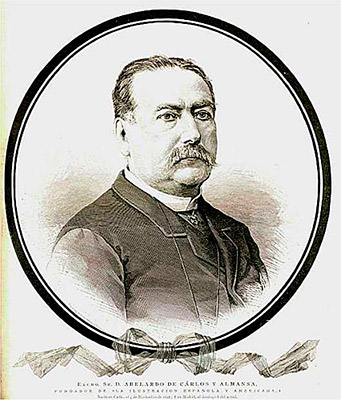
Born in Cadiz, little is known about the early stages of this brilliant entrepreneur, although it is clear that he was a lucid and cultivated person. There are even those who believe that he was present in America, although there is no documentary proof of this. His love affair with the world publishing house began in his youth, when he edited two publications in his native city: the Revista Médica and La Moda Elegante e Ilustrada ( 1849). However, at that time the leading illustrated magazine was El Museo Universal, a periodical on science, literature, the arts, industry and useful knowledge founded in 1857, which included very good quality lithographs.
De Carlos moved to Madrid in 1869 and contacted the owners of El Museo Universal, Fernando Roig and José Gaspar Maritany, to whom he proposed the purchase of the publication, which had begun to decline. After the acquisition, he created a young but enthusiastic editorial staff, and began a continuation of the journal under the title La Ilustración Española y Americana, not only because of its content but also because of its readership, since in addition to Spain, it had numerous subscribers in America. The subtitle of the publication read Museo Universal, which demonstrated the new owner's desire for continuity.

The literary direction was under the supervision of Román Goicoerrotea and the artistic direction at position of the engraver Bernardo Rico. To cover the news, it incorporated career graphic and literary correspondents, although on many occasions it made use of regular contributors, many of them subscribers to the publication, such as Beauchy, Laurent, Ramiro Franco, Coyne, Ricardo Huerta, Montenegro, Rocafull, Compañy and Almagro.
The first issue was published on Christmas Day 1869 and was initially published fortnightly, which became a biweekly in 1870 and a weekly in 1872. With a format of 41.5 x cm, the publication was divided into two luxuriously bound annual volumes that were paginated independently. The cover illustration was made by Eduardo Rosales and remained until the second period of the magazine (1915).
In terms of its structure, although it varied in nomenclature and order on some occasions, it had sections explaining the cover image, the engravings inside and the scientific news. There was also space for national and foreign chronicles, literary criticism and even stories by renowned authors. The last pages included pastimes and, of course, advertising.
Abelardo de Carlos never neglected the quality of the publication's illustrations, which were exchanged with those of the most important European magazines, nor the plethora of artistic and literary collaborators who took part in it. Among the illustrators were painters and draughtsmen of the stature of the aforementioned Rico, Ferrant, Comba, Pellicer, Ortego, Carretero and Capuz, among many others, whose biographies are discussed at section "The Authors". Among the writers who contributed their creations were Zorrilla, Campoamor, Clarín, Valle Inclán and Unamuno.
Despite having such distinguished collaborators, La Ilustración did not neglect the new promises of the Spanish literary and artistic scene, and from its beginnings it made use of competitions, only surpassed in prestige and economic value by the national exhibitions, of public initiative. Unless they coincided with an event, which rarely happened, the competitions, which included the photographic discipline at the turn of the century, were not organised around a particular topic ; creative freedom prevailed.
The founder took advantage of the tragic circumstances that accompanied the ruin of the original headquarters in 1872 to build a new printing press that aroused the admiration of all Spanish and many European publications. De Carlos spared no expense in its reconstruction, incorporating the most cutting-edge technology of the time, which had a very positive effect on the quality and acceptance of the magazine.

De Carlos left the directorship in 1881, and his son Abelardo José took over position until 1898, when he resigned to devote himself to other professional activities. His policy of continuity meant that essentially no changes were made, except for the incorporation of the first photographs (1895) and chromolithographs.
He was succeeded by his brother-in-law, Alejandro Moreno y Gil de Borja, the last administrator of the magazine in its first period. Under his direction, graphic illustration was gradually replaced by photographic illustration, the former being limited to residual and secondary information within the publication's speech .
After the sale of La Ilustración in 1914, its quality declined, which led, despite the efforts of the new owners, to readers opting for other periodicals that were in full swing, such as Blanco y Negro, founded by Torcuato Luca de Tena in 1891, or the illustrated magazine La Esfera, which came out that same year and won general critical acclaim for both its contributions and its luxurious edition. Unable to cope with the skill, La Ilustración languished until its virtual disappearance in December 1921. In its almost 2,500 issues, half a century of Spanish history was preserved.
In the period chosen for the exhibition, from the founding of the illustrated magazine in December 1879 until the arrival of the 20th century, lithographs referring to Navarre, its history and its great figures appeared on more than a few occasions. In more than 1,400 issues analysed, a total of 120 engravings have been found, although they are distributed rather unevenly, with some years being wasted and others full of illustrations.
In comparison with other Spanish territories, it can be categorically affirmed that illustrations from Navarre are residual, bearing in mind that each of the magazines contains more than a dozen lithographs. Perhaps the virtual absence of correspondents, the distance from the capital or its then little importance in the national economy dented their appearances, which were limited to monographic articles, extraordinary events, and figures of national relevance.
As for artists - excluding the editors - of Navarrese origin, there are barely a handful of them, with a few painters (Asarta and Zubiri), draughtsmen (the brothers Aniceto and Nemesio Lagarde) and photographers based in the capital (Pliego, Roldán, Mena and Dublán) standing out. At section the virtual exhibition "The Authors" offers a portrait of both the Navarrese artists and the national and international artists.
With regard to its distribution during the period under study, nothing is mentioned about Navarre during the first three years of the magazine's existence, until the beginning of the Third Carlist War (1872-1876), when the Navarrese topic , in the form of battles, maps, characters and events, became of particular interest at a national level, which led to a proliferation of lithographs in the publication. This enabled interested Spaniards to follow the evolution of the civil conflict in an illustrated, reliable and up-to-date manner. It was during this period that 82 of the 119 engravings referred to above were printed. A large part of this set has been studied and incorporated into different monographs in recent years -mainly by Francisco Javier Caspistegui and Ignacio Urricelqui-, and would perhaps merit a detailed study in the form of a monographic publication.
This is why the virtual exhibition presented here is limited exclusively to the remaining 38 lithographs, which are divided into various subgroups in the section "Engravings" section: "Views", in which mainly urban spaces and landscapes are studied; "Portraits", in which those illustrious Navarrese who aroused the interest of the publication are described; "Reproductions", which includes engravings and photographs that faithfully reproduce works of art from Navarre or related to the Old Kingdom and its history; and "Royal Affairs", which deals with the relationship between the Spanish monarchy and Navarre.
This distribution is the one that best fits the content, although it is true that some of the lithographs could be included in two of the established categories. What happened between the turn of the century and the disappearance of La Ilustración ( 1921) remains to be investigated at a later date, although the artistic quality of the magazine declined, with the incorporation of the photographic technique from plenary session of the Executive Council , which eclipsed and ended up annihilating the other disciplines that did come together during the period under study.
Fortunately, both the signatures and the texts accompanying the illustrations on display in this exhibition have left their authorship on record. Sometimes they are simple witnesses to events -usually military- who sent their sketches or photographs to the editorial office of La Ilustración. Once they had been received, they were adapted by a draughtsman partner and later engraved by the publication's chief lithographer. For this reason, sometimes there were up to three authors for the same composition. The opposite may also be the case, with just one author in charge of the whole process.
Therefore, in the execution of the lithographs of The Enlightenment , different disciplines come together: on the one hand, engravers and painters; on the other, photographers and photoengravers. In this regard, it should be pointed out that the technique of photoengraving was only applied in the last two decades of the 19th century, and gradually displaced painting and lithography, a fact that is already evident at the turn of the century. This section has therefore been subdivided into two groups: on the one hand, engravers and painters, and on the other, photographers and photoengravers, providing a basic sketch of each of them.
ENGRAVERS AND PAINTERS
-
Félix Badillo y Rodrigo (1848-c. 1895)
He was a draughtsman, lithographer and painter from Segovia. After completing his studies he moved to Madrid, where he enrolled at the Special School of Painting and worked as a copyist at the Prado Museum. During the Third Carlist War he published a large number of lithographic works that earned him a good reputation in the capital, which he combined in later years with his work as a portraitist and professor. In any event, he devoted most of his time to drawing for periodicals, starting out as an illustrator for the weekly La Ilustración Española y Americana, where he worked until at least 1897.
-
Ricardo Balaca y Orejas-Canseco (1844-1880)
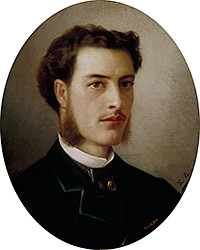 The son of the painter José Balaca, who was exiled in Portugal, he moved to Madrid, where he studied at the San Fernando Academy of Fine Arts, cultivating genres associated with the Romantic movement such as genre painting, landscape and portraiture. He excelled in national war scenes, skill , which enabled him to accompany King Alfonso XII as a photojournalist and chronicler during the Third Carlist War in his northern campaign (1876). His untimely death left an unbridgeable void in the national pictorial panorama.
The son of the painter José Balaca, who was exiled in Portugal, he moved to Madrid, where he studied at the San Fernando Academy of Fine Arts, cultivating genres associated with the Romantic movement such as genre painting, landscape and portraiture. He excelled in national war scenes, skill , which enabled him to accompany King Alfonso XII as a photojournalist and chronicler during the Third Carlist War in his northern campaign (1876). His untimely death left an unbridgeable void in the national pictorial panorama.
-
Tomás Carlos Capuz (1834-1899)
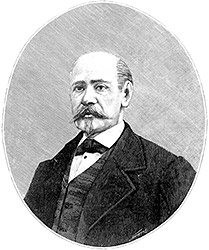 A Valencian xylographer trained at the San Fernando Royal Academy, he is considered one of the great engravers of the 19th century. His worth was proven by several awards at the national Fine Arts exhibitions. In addition to his engravings for novels and serialised novels, he also illustrated periodicals such as The Universal Museumthe Spanish Picturesque Weekly o The Spanish and American Enlightenmentand works of interest such as the Dictionary of Madoz. According to an obituary published in La Correspondencia de Españadied a widower, blind, old and forgotten in the Asilo de las Hermanitas de los Pobres in Madrid.
A Valencian xylographer trained at the San Fernando Royal Academy, he is considered one of the great engravers of the 19th century. His worth was proven by several awards at the national Fine Arts exhibitions. In addition to his engravings for novels and serialised novels, he also illustrated periodicals such as The Universal Museumthe Spanish Picturesque Weekly o The Spanish and American Enlightenmentand works of interest such as the Dictionary of Madoz. According to an obituary published in La Correspondencia de Españadied a widower, blind, old and forgotten in the Asilo de las Hermanitas de los Pobres in Madrid.
-
Arturo Carretero y Sánchez (1847-1903)
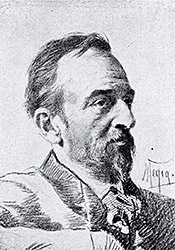 Born in Santiago, he worked as a woodcutter and was one of the most important woodcutters of his time in Spain discipline. Throughout the second half of the 19th century, he produced a large number of engravings for various periodicals, the most important of which were The Spanish and American Enlightenment. However, his work was affected by the appearance of photoengraving, and he worked in Madrid as a draughtsman until his death. The famous engraver Enrique Mayer, a fellow countryman of his, trained in his Madrid workshop.
Born in Santiago, he worked as a woodcutter and was one of the most important woodcutters of his time in Spain discipline. Throughout the second half of the 19th century, he produced a large number of engravings for various periodicals, the most important of which were The Spanish and American Enlightenment. However, his work was affected by the appearance of photoengraving, and he worked in Madrid as a draughtsman until his death. The famous engraver Enrique Mayer, a fellow countryman of his, trained in his Madrid workshop.
-
Juan Comba García (1852-1924)
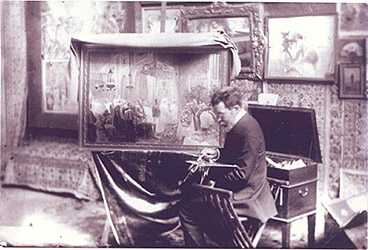
After beginning his military career, he entered the Special School of Painting, Sculpture and Engraving at the San Fernando Royal Academy of Fine Arts as a disciple of Eduardo Rosales, who placed him at contact with Abelardo de Carlos, director of La Ilustración Española, where Comba published his illustrations from March 1872 to 1907. In 1880 he obtained a pension to travel to Italy, France, Belgium and Germany, which enabled him to become acquainted with the artistic currents of the time. He had the honour of accompanying King Alfonso XII on all his trips around Spain, as well as on his tour of Central Europe, for which the Royal Household distinguished him with honours and official posts, as can be seen in several lithographs in this exhibition.
-
José Cusachs y Cusachs (1851-1908)
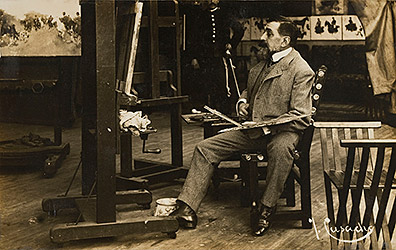
He was a Spanish military officer and painter. Born in Montpellier by accident, he spent his whole life between Barcelona and Mataró. He left the military to devote himself to art, although he specialised in military themes, particularly cavalry. He studied with Simón Gómez and in Paris with Édouard Detaille, an expert in military themes. From 1880 onwards his participation in exhibitions and competitions - both national and international - raised his status, and he was sought after by royalty and the government on many occasions. He also showed himself to be a skilful portraitist and practised religious painting on a residual basis. On the other hand, his lack of experience with landscape painting meant that he often entrusted the landscape part of his works to other painters, such as Joaquim Vancells.
-
Inocencio García Asarta (1862-1921)
Although he was born in Navarre, his life and pictorial production are linked to the city of Bilbao. He studied at the School of Arts and Crafts in Vitoria and completed his trainingin Rome, Barcelona, Paris and Madrid, before settling permanently in Bilbao, where he set up his residency programand his studio. His travels around various European cities enabled him to become acquainted with the art and culture of his time, although as a painter he remained within a traditional style, always emphasising his skills as a draughtsman. In his activity as a painter he cultivated portraiture, becoming one of the most sought-after portraitists of the bourgeoisie of Bilbao, although he also worked in other genres such as genre painting, still life, landscape and, to a lesser extent, engraving.
-
Nemesio Lagarde y Carriquiri (1845-1902)
A member of a family of artists, and leaving aside his military facet, he emphasised his skill as an illustrator of magazines such as Ilustración Militar and La Ilustración Española y Americana, which made him Balaca's successor: "There is only one illustrator in Spain who has the secret of Balaca's surprising grace and naturalness. This illustrator is Lagarde; but he lives in Spain, he is a military man, and in our country there is the pious custom of not granting military men even the right to think. In another country, Lagarde would be very well known, and his name would be popular and esteemed; here he is just another little soldier". Another reference to his work is to be found in the Royal Order by which he was awarded, by virtue of his work professor and graphics, the first cross class for military merit in 1893: "Captain Lagarde is undoubtedly one of the best draughtsmen known in Spain. He has a marvellous facility with the pencil and conceives his subjects with such precision that he rarely has to retouch or modify anything of what he sketches with inimitable fluency from his first intention".
-
José San Bartolomé "Llaneces" (1864-1919)
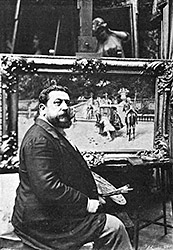 A painter and sculptor from Madrid whose artistic inclination arose through his work in the studio of the photographer Herbert and his training at the School of Arts and Crafts. He also attended the San Fernando Royal Academy and worked as a copyist at the Prado Museum. In 1886 he settled in Paris, where, following in Fortuny's artistic footsteps, he focused on genre and house painting, receiving considerable institutional recognition in both France and Spain. At the beginning of the 20th century, under the protection of royalty, he returned to Madrid, where he focused chiefly on portraiture. He remained there until his tragic end, in the form of suicide, in 1919.
A painter and sculptor from Madrid whose artistic inclination arose through his work in the studio of the photographer Herbert and his training at the School of Arts and Crafts. He also attended the San Fernando Royal Academy and worked as a copyist at the Prado Museum. In 1886 he settled in Paris, where, following in Fortuny's artistic footsteps, he focused on genre and house painting, receiving considerable institutional recognition in both France and Spain. At the beginning of the 20th century, under the protection of royalty, he returned to Madrid, where he focused chiefly on portraiture. He remained there until his tragic end, in the form of suicide, in 1919.
-
José Moreno Carbonero (1860-1942)
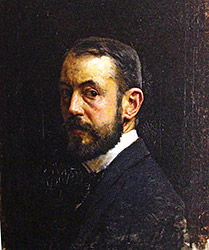 He was a painter from Malaga who specialised in portraits and historical subjects. After training at the Malaga School of Fine Arts, where he was a pupil of Ferrándiz, he worked in Paris in the studio of Jean-Leon Gérôme, a painter who passed on to him a taste for historical themes. This was the first of several trips that included Rome and Morocco, the latter in the company of his master and Mariano Fortuny. He combined his work professor (he counted Dalí and Picasso among his most outstanding pupils), with that of an academician of San Fernando and that of a skilful portraitist, although his fame was based on his history paintings, which were highly praised from the 1880s onwards.
He was a painter from Malaga who specialised in portraits and historical subjects. After training at the Malaga School of Fine Arts, where he was a pupil of Ferrándiz, he worked in Paris in the studio of Jean-Leon Gérôme, a painter who passed on to him a taste for historical themes. This was the first of several trips that included Rome and Morocco, the latter in the company of his master and Mariano Fortuny. He combined his work professor (he counted Dalí and Picasso among his most outstanding pupils), with that of an academician of San Fernando and that of a skilful portraitist, although his fame was based on his history paintings, which were highly praised from the 1880s onwards.
-
Manuel Nao (1843-1884)
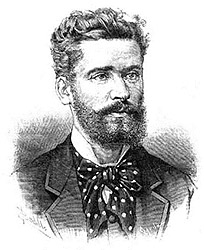 He was a draughtsman, gold embroiderer, illustrator and carver from Madrid who trained with Luis Ferrant and José M. Vallejo. In addition to his participation in various national exhibitions, he worked as an artistic assistant at the Depósito Hidrográfico, a job he combined with illustrating books and collaborating in various periodicals, such as The Catholic Enlightenment y The Spanish and American Enlightenment. He died prematurely in his hometown and was buried in the cemetery of San Isidro.
He was a draughtsman, gold embroiderer, illustrator and carver from Madrid who trained with Luis Ferrant and José M. Vallejo. In addition to his participation in various national exhibitions, he worked as an artistic assistant at the Depósito Hidrográfico, a job he combined with illustrating books and collaborating in various periodicals, such as The Catholic Enlightenment y The Spanish and American Enlightenment. He died prematurely in his hometown and was buried in the cemetery of San Isidro.
-
Tomas Padró i Pedret (1840-1877)
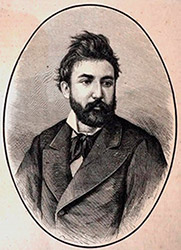 He was a painter, illustrator and caricaturist from Barcelona who came from a family of artists. He studied at the School of Fine Arts in Barcelona and later at the San Fernando Royal Academy of Fine Arts in Madrid. After travelling to Paris and devoting himself to teaching, he began the zenith of his career, coinciding with the Revolution of 1968. With the arrival of the monarchy of Amadeo I, he went to Cartagena, where he worked as the artistic correspondent for The Spanish and American Enlightenment. He also contributed to other similar periodicals, such as The Universal Museum o The Military Worldand in satirical weeklies such as La Flaca and the Gràcia Bell. He cultivated a wide variety of genres, from political cartoons to history painting and portraiture. His illustrations also appeared in foreign magazines such as L'Illustration, Illustrirte Zeitung y Le Monde Illustré.
He was a painter, illustrator and caricaturist from Barcelona who came from a family of artists. He studied at the School of Fine Arts in Barcelona and later at the San Fernando Royal Academy of Fine Arts in Madrid. After travelling to Paris and devoting himself to teaching, he began the zenith of his career, coinciding with the Revolution of 1968. With the arrival of the monarchy of Amadeo I, he went to Cartagena, where he worked as the artistic correspondent for The Spanish and American Enlightenment. He also contributed to other similar periodicals, such as The Universal Museum o The Military Worldand in satirical weeklies such as La Flaca and the Gràcia Bell. He cultivated a wide variety of genres, from political cartoons to history painting and portraiture. His illustrations also appeared in foreign magazines such as L'Illustration, Illustrirte Zeitung y Le Monde Illustré.
-
Carlos Penoso (c. 1877)
Little information is known, except that he was a professor of woodcut at the School of Arts and Crafts in Montevideo and partner of the magazine La Ilustración Uruguaya ( 1883). He specialised in the faithful reproduction of large canvases, preferring history painting and literary illustration. The appearance of photogravure dented his production, which was detected in La Ilustración Española y Americana until 1887.
-
Bernardo Rico y Ortega (1830-1894)
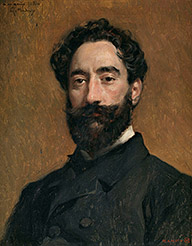 He was the brother of the painter Martín Rico. He was born in El Escorial and trained in Madrid with Vicente Castelló and Calixto Ortega. His first works appeared in the last volumes of the Spanish Picturesque Weekly and The EnlightenmentHe was the initiator in Spain of the genre of illustrated publications, winning several awards at national Fine Arts exhibitions. He illustrated a multitude of novels and from the 1970s onwards collaborated with the Universal Museum and, above all, with The Spanish and American EnlightenmentHe occupied the place of director and took an active part in his work until his death. One of his obituaries clearly described his worth: "Few prints had been published in Spain since 1850, to illustrate novels, to decorate works, to reproduce monuments, that did not bear the signature of Bernardo Rico as an engraver".
He was the brother of the painter Martín Rico. He was born in El Escorial and trained in Madrid with Vicente Castelló and Calixto Ortega. His first works appeared in the last volumes of the Spanish Picturesque Weekly and The EnlightenmentHe was the initiator in Spain of the genre of illustrated publications, winning several awards at national Fine Arts exhibitions. He illustrated a multitude of novels and from the 1970s onwards collaborated with the Universal Museum and, above all, with The Spanish and American EnlightenmentHe occupied the place of director and took an active part in his work until his death. One of his obituaries clearly described his worth: "Few prints had been published in Spain since 1850, to illustrate novels, to decorate works, to reproduce monuments, that did not bear the signature of Bernardo Rico as an engraver".
-
Eduardo Rosales Gallinas (1836-1873)
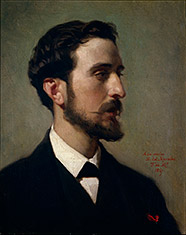 A Madrid painter of humble origins, he entered the San Fernando Royal Academy of Fine Arts in 1851, where he was student under Federico Madrazo. He completed his training in Rome, where he favoured realism, and took part in the Paris Universal Exhibition of 1867 with resounding success. After falling ill with tuberculosis, he returned first to Madrid and later, in search of a better climate, to Murcia. Despite his efforts his health did not improve and, on returning to Madrid, he died prematurely.
A Madrid painter of humble origins, he entered the San Fernando Royal Academy of Fine Arts in 1851, where he was student under Federico Madrazo. He completed his training in Rome, where he favoured realism, and took part in the Paris Universal Exhibition of 1867 with resounding success. After falling ill with tuberculosis, he returned first to Madrid and later, in search of a better climate, to Murcia. Despite his efforts his health did not improve and, on returning to Madrid, he died prematurely.
-
Enrique Zubiri y Gortari (1868-1943)
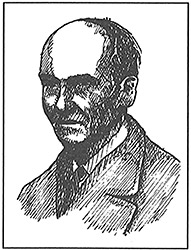 Born in Valcarlos (Navarre), he studied in San Juan Pie del Puerto and Paris. He then enrolled at the Pamplona School of Arts and Crafts under the tutelage of the Valencian painter Eduardo Carceller and completed his training at the San Fernando Royal Academy of Fine Arts. He carried out a multifaceted career in Navarre: partner in the local press as a draughtsman and art critic; official portraitist of the city for nearly forty years; member of municipal and provincial juries; and, above all, teacher of drawing at the Pamplona School of Fine Arts and Crafts for nearly fifty years, training practically all the Navarrese artists of the twentieth century.
Born in Valcarlos (Navarre), he studied in San Juan Pie del Puerto and Paris. He then enrolled at the Pamplona School of Arts and Crafts under the tutelage of the Valencian painter Eduardo Carceller and completed his training at the San Fernando Royal Academy of Fine Arts. He carried out a multifaceted career in Navarre: partner in the local press as a draughtsman and art critic; official portraitist of the city for nearly forty years; member of municipal and provincial juries; and, above all, teacher of drawing at the Pamplona School of Fine Arts and Crafts for nearly fifty years, training practically all the Navarrese artists of the twentieth century.
PHOTOGRAPHERS AND PHOTOENGRAVERS
-
Alphonse Isidore Chalot (d. 1893)
Parisian photographer, member of the Société Française de Photographie, who, in association with his brother Arturo (MM. Chalot et Cie.), bought the photographic studio of Franck and Gobinet de Villecholles (Paris, 18 rue Vivienne) in 1880. He remained active until 1890, when he transferred it to the photographer Camus. He won the gold medal at the Universal Exhibition in Paris in 1899.
-
Domingo Dublán Elicechi
Photographer. Together with Leandro Desages, he opened an office in 1876 on the slope of Santo Domingo in Pamplona. They devoted themselves mainly to studio portraits, although they also left the studio to take pictures of subjects that aroused a certain interest in the city. They broke off their relationship in 1888, when Dublán set up a new business with another photographer, Valentín María Aizpurbe, who was little known at the time.
-
Emilio Pliego (c. 1934)
He was born in Madrid and was a member of the Société Française de Photographie. He settled in Pamplona in 1876, in partnership with the Frenchman Leopoldo Ducloux, although by 1879 he was already established in an independent studio (San Nicolás, 2). The establishment, one of the most prestigious in the capital, remained in that location until 1887, when it moved to the Crédito Navarro building (place del Castillo, 22), and remained in business until 1922.
-
José Roldán Bidaburu / Félix Mena Martín (1860-1934/ 1861-1935)
Photographer from Guipuzcoa who settled near Calle Chapitela in Pamplona. When the Iruña house was later built, he moved in with his partner, the Burgos-born Félix Mena Martín. Some of his business cards mention a number of galleries (numbers 44, 35, 47 and 48 of place del Castillo), which suggests that he changed premises several times. He was dedicated not only to portraits, but also to taking views of the city. At the beginning of the 20th century, the Roldán-Mena association was dissolved and, after 1910, the name "Roldán e hijo" can be found at number 40 of place.
-
Historical-Photographic Society of Madrid (1880-1898)
The company was founded by the businessmen and amateur photographers Piñal and Liñan around 1880. It is the origin of the famous Hausaer and Menet house. In 1890, in order to professionalise the studio, its owners requested the services of an expert, the Swiss photographer Adolfo Menet Kursteiner. He arranged for his compatriot Oscar Hauser Muller to be hired. Shortly afterwards, Hauser and Menet became independent. Later, in 1898, the Sociedad Artístico-Fotográfica de Madrid was transferred by its owners to Antonio Portela Paradela.
-
Alfonso Ciarán
Photographer who ran a well-known studio in Madrid (Quintana, nº 32) from 1896 until the 1930s. Initially he specialised in zincography and chromotypography, later focusing on photoengraving. By 1900 many publications from all over subject were illustrated with his high quality work.
-
Brothers [Francisco and Enrique] Laporta Valor (1850-1914 / 1842-1919)
They were both from Alicante and trained as painters and engravers, respectively, at the Real Academia de San Fernando in Madrid. After the former's stay in Paris, where he entered contact with the world of photography, they settled in Alcoy in 1880. There they became interested in the technique of photoengraving, patenting a new procedure that allowed them to obtain direct images from life, which they marketed through the company Laporta Hermanos (together with his other brother Vicente) based in Madrid, from where they attended to the orders that arrived from all over Spain until 1914. Their photoengravings filled the illustrated publications of the turn of the century.
-
Joseph Thomas y Bigas (1852-1910)
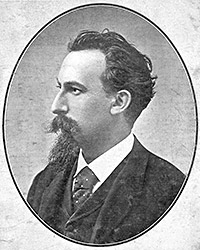 A photoengraver and printer from Barcelona, he introduced the technique of phototypesetting in Spain. In 1876 he travelled to Paris, where he trained in the photoengraving technique with Gillot. On his return, he established "Casa Thomas" in Mallorca Street, one of the largest printing houses in Europe at the time. The establishment operated for more than half a century, run by his heirs until the end of the 1940s under the name "Hijos de J. Thomas".
A photoengraver and printer from Barcelona, he introduced the technique of phototypesetting in Spain. In 1876 he travelled to Paris, where he trained in the photoengraving technique with Gillot. On his return, he established "Casa Thomas" in Mallorca Street, one of the largest printing houses in Europe at the time. The establishment operated for more than half a century, run by his heirs until the end of the 1940s under the name "Hijos de J. Thomas".
LIST OF IMAGES AND AUTHORS
|
Illustration |
Year |
Author |
|
Emilio Arrieta |
1877 |
Rico |
|
Pablo Sarasate |
1877 |
(s/i) |
|
Julián Gayarre |
1877 |
Badillo / Carretero |
|
Ricardo Alzugaray |
1878 |
Badillo / Capuz |
|
Hilarión Eslava |
1878 |
(s/i) |
|
Baths of Fitero |
1878 |
Nao/ Rico |
|
Pablo Sarasate |
1880 |
Badillo / Carretero (f) |
|
Prison of Doña Blanca de Navarra |
1880 |
Rosebushes / Pitiful |
|
Domingo Moriones |
1881 |
Badillo |
|
Funeral of Domingo Moriones |
1881 |
J.M. Gómez*. |
|
San Cristobal hill defence works |
1881 |
Lagarde / Rico |
|
The Prince of Viana |
1882 |
M. Carbonero / Rico |
|
Julián Gayarre |
1884 |
Chalot / Carretero |
|
The king in Betelu. Room of H.M. |
1884 |
Comba / Carretero |
|
The king in Betelu. Various scenes |
1884 |
Comba / Rico |
|
H.M. the King reviews three corps of the Army of the North |
1885 |
Padró / Balaca /Rico |
|
Joaquín María Guelbenzu |
1886 |
(s/i) |
|
Pamplona, visit de SS.MM. |
1887 |
Comba/ Rico |
|
Pamplona. Chariot of the triumphant Mars |
1887 |
(f) |
|
Evaristo Churruca |
1888 |
Road |
|
Pamplona. Foundation of Pinaqui |
1890 |
R. de Ojeda(*) / Rico |
|
Julián Gayarre in the costume of "El pescador de perlas". |
1890 |
S. H-F /Rico |
|
project de Mausoleum to Julián Gayarre |
1890 |
Sanchís (f*) / Rico |
|
Pamplona. Laying of the first stone of the Palace of Justice. |
1890 |
Zubiri / Rico |
|
Javier Los Arcos y Miranda |
1891 |
Road |
|
Reparacea. Inauguration of the livestock and fish stations. |
1891 |
Asarta / Rico |
|
The venerable Palafox. |
1892 |
Ibáñez (f*) / Rico |
|
Dr. Alejandro San Martín |
1892 |
Road |
|
Baztan March |
1892 |
Cusach /Rico |
|
Navarre. Irache Monastery |
1893 |
Rico |
|
Navarre. Castle of Javier |
1895 |
Villafuerte (f*) / Capuz |
|
Navarre. conference room capitular de La Oliva |
1895 |
Pliego /Capuz |
|
Pablo Sarasate |
1896 |
Llaneces (f) / Capuz |
|
The Pamplona Orfeón |
1897 |
Thomas |
|
Mr. Joaquín Osés y Rodríguez de Arellano |
1898 |
(f) |
|
Pamplona. The new courthouse |
1898 |
Roldán / Laporta |
|
Cirauqui. Gate of San Román |
1899 |
Dublán / Ciarán |
|
Sangüesa. Santa Maria's façade |
1899 |
Dublán / Ciarán |
|
Abbreviations: (f) photographic; (s/i) unidentified; (*) amateur author. |
||
PORTRAITS
Approximately a third of the lithographs are dedicated to eminent people from Navarre, known nationally and even internationally. They belong to fields as diverse as music, the army and politics, among many others.
Beginning with music, the first of the engravings sample features the image of the bridgeman Emilio Arrieta (1821-1894), famed composer, theatre producer and director of the Escuela Nacional de Música, who played a very important role in the consolidation of zarzuela as a properly Hispanic genre. The three-quarter portrait appears on the cover of issue 6 of 1877, and was engraved by Bernardo Rico. Inside is a biography of the composer.
The Illustration includes two images of the most famous violinist Pablo Sarasate (1844-1908), whose career is well known in the popular imagination of Navarre. The first of these (1877, no. 21, p. 364), presents a bust portrait, autographed with the violinist's initials, and with no indication of the engraver. It is accompanied by a short biographical sketch inside the issue. Three years later (1880, no. 10, p. 162), he appears on the cover with the excuse of his imminent trip abroad after his triumph in the capital. It is again a bust portrait, although with a more refined invoice than the previous one. The composition was inspired by a photograph and was drawn by Badillo and engraved by Carretero.
Nor is it surprising that the best tenor to come out of Navarre, Julián Gayarre (1844-1890), appears on three occasions. The composition, executed by the Badillo-Carretero tandem, presents his bust practically from profile, and the inside of the magazine (1877, no. 38, p. 244.) includes a chronicle of his last performance in Madrid and a portrait of the artist. Years later (1884, no. 11, p. 178) he appears on the cover with a three-quarter portrait, dressed as a tenor, executed by Carretero and inspired by a photograph by Chalot et cie. It can be found inside the magazine and is accompanied by a chronicle of his triumph at the Italian Theatre in Paris. The last reference to the tenor in question appears on a full page inside the magazine (1890, no. 1, p. 8). The portrait is full-length and was engraved by Rico, who in turn was inspired by a photograph from the Sociedad Artístico-Fotográfica de Madrid. He appears dressed as "The Pearl Fisherman", the last opera he sang in Paris in poor health. It is accompanied, by way of homage, by an extensive eulogy.
Another distinguished Navarrese connected with music was Hilarión Eslava (1807-1878), a priest, composer and musicologist from Burladó who became maestro of the Royal Chapel in Madrid and was awarded important civilian honours such as the Grand Cross of Isabella the Catholic, the Order of Charles III and the Grand Cross of the Civil Order of María Victoria. The portrait, located inside the magazine (1878, no. 38, p. 68), has no signature to identify its authorship. It is accompanied by a very extensive obituary, which covers almost the entirety of his life, and stands as a eulogy at the time of his death.
La Ilustración also devoted space to the eminent Pamplona pianist and composer Juan María Guelbenzu (1819-1886). He replaced Albéniz as the first organist of the Capilla Real de Madrid and won numerous national and international awards. A member of the music section of the Royal Academy of Fine Arts of San Fernando, Alfonso XII awarded him the Grand Cross of the Order of Isabella the Catholic, and the King of Portugal made him a knight of the Order of Our Lady of the Conception of Villaviciosa. The bust portrait appears inside the magazine (1886, no. 2, p. 28) and is accompanied by a very extensive obituary that deals with his life and professional career. It lacks accreditation of authorship.
The last reference to Navarre in the musical field is a group portrait of the members of the Orfeón Pamplonés ( 1897, no. 33, p. 372), produced using the photoengraving technique by the Casa Thomas in Barcelona. It appears inside the magazine and is accompanied by an extensive article giving an account of the success of the Pamplona choral association since its re-founding in 1890, and more specifically of two of its concerts held in Madrid on 6 and 8 June 1897, under the direction of Remigio Múgica.
There are also references to the world of national politics, starting with Ricardo Alzugaray y Yanguas (d. 1878), a member of the Cortes on several occasions in the second third of the 19th century, who participated intensely in parliamentary life in numerous commissions, especially in the one concerning the construction of the railway from Pamplona to France project . He received the Grand Cross of Military Merit for his war services in 1870 and 1875. In the twilight of his political career, he sought the certificate in other lands, being elected in 1876 for the district of Lalín de Pontevedra and, in 1878, for the district of Alcoy. During those years he was director general of Politics and Administration, undersecretary of the Interior and prosecutor of the Supreme Court. The bust portrait was drawn by Badillo and engraved by Capuz. It appears inside the magazine (1878, no. 40, p. 260) and is accompanied by an obituary of the Navarrese politician.
Javier Los Arcos y Miranda (1847-1905), a Navarrese politician and military engineer born in Sangüesa, also appears. After taking an active part in the Third Carlist War, improving the fortifications of Pamplona and Bilbao, he was a member of Parliament for the Conservative Party between 1876 and 1893, when he defended Navarrese interests during the Gamazada. A member of the Royal Academy of Sciences from 1890, he was also director general of Communications, of Penal Establishments and board member of the Board of Tariffs. The bust of profile, published inside the magazine (1891, no. 33, p. 148), was engraved by Carretero and was accompanied by a text praising his work.
Another outstanding figure, more military than political, was Lieutenant General Domingo Moriones y Murillo (1823-1881). Born in Leache, he is a figure core topic to understand the development of the 3rd Carlist War on its northern front, as in 1872 he defeated the Carlist pretender in the famous action of Oroquieta, which, apart from his promotion, earned him the marquisate of the same name. From then on he rose through the military ranks, holding the captaincy generalship of the Philippines in the last years of his life. La Ilustración Española y Americana offered two engravings that illustrated an extensive obituary praising this particular hero of the country (1881, no. 2, p. 28). The first of these is a bust portrait, with the large cross of Saint Hemenegildo on his chest, drawn by Badillo and engraved by Carretero; the other reproduces the scene of his burial in the cemetery of Ejea de los Caballeros, the town where his wife was from and which made him an adopted son. The lithograph was inspired by a sketch submitted by J. Miguel Gómez, an eyewitness who seems to have signed the composition.
Another important military officer was Joaquín Osés y Rodríguez de Arellano (1841-c. 1911). A native of Mendigorría, he joined the Borbón Regiment as a cadet in 1857, and in 1868 he was already a captain. Two years later he volunteered to go to Cuba, where he rendered excellent services that earned him three Red Crosses and promotion to Commander. Back on the Peninsula, he was secretary of the Military Government of Orense and was promoted to colonel in 1890. He was then head of the military zones of Cieza, Lora, Vergara and Lugo, until 1895, when he again asked to go to Cuba, where, for his courageous conduct, he was promoted to brigadier general in 1898, and was awarded the Grand Cross of San Hermenegildo in 1899. He retired in 1911, at the age of seventy. The photogravure of the soldier, with no reference to his authorship, can be found inside the magazine (1898, no. 9, p. 143), which gives an extensive biography on the occasion of his promotion to brigadier general.
Outside the military sphere, the publication also offers a portrait of Evaristo Churruca y Brunet (1841-1917). Born almost circumstantially in Izu, he was an important engineer who completed his training in Madrid, Murcia, Valencia, Puerto Rico, the United States and Havana. On his return to the Peninsula, he became position for the construction of the outer port of Bilbao and the canalisation of the River Nervión (1877-1904). In recognition of his services, Alfonso XIII named him Count of Motrico, and he also received other prestigious national and international decorations, such as the Cross of the Order of Charles III, the Grand Cross of the Order of Isabella the Catholic and the French Legion of Honour. The engraving, made by Carretero, appears inside the magazine (1888, no. 39, p. 228) and is accompanied by an extensive biography that culminates with the work he was carrying out in the port of Bilbao.
Finally, La Ilustración offers a portrait of the illustrious doctor Alejandro San Martín (1847-1908). Born in Larrainzar, he trained at the Central University of Madrid and later practised as a "spur doctor" in Navarre. In 1874 he obtained the chair of General Therapeutics at the University of Cadiz and in 1882 that of Surgical Pathology at the Central University of Madrid. During the cholera epidemic in Valencia (1885), he studied the aforementioned disease and its treatment, which catapulted him to the National Academy of Medicine in 1888. That same year he began his political career as a senator until his death, which was momentarily interrupted in 1906, during the brief government of Segismundo Moret, who appointed him Minister of Public Instruction and Fine Arts. On the inside of the magazine is his bust, executed by Carretero (1892, no. 26, p. 21). The accompanying article reports on a lecture series given at the Madrid Athenaeum on the epidemics related to the conquest of America on its fifth centenary.
VIEWS
Seven of the lithographs in the Enlightenment in the period studied correspond to views of Navarre. Some of them circumstantially illustrate an article, while others are in themselves the essence of the publication.
The first of these, sample , shows the exterior of the Fitero Spa. It can be found inside the magazine (1878, no. 36, p. 82) and is accompanied by an article describing the renovation of the establishment and the services it offered at the time. Based on a sketch by Aniceto Lagarde, preserved in a private collection, it was drawn by Nao and lithographed by Rico.
The following sample shows the fortification work carried out by the corps of military engineers on the San Cristóbal hill for the construction of the fort of Alfonso XII. Published full-page (1881, no. 15, p. 253) and accompanied by a brief description of the work, it was engraved by Rico following a sketch submitted by Nemesio Lagarde.
A lithograph is also preserved, sample , of Salvador Pinaqui's foundry, once located outside the walls of Pamplona, on the banks of the Arga. It was published inside the magazine (1890, no. 1, p. 5) in order to illustrate the biography of Julián Gayarre, as he earned his living in that establishment before becoming a prominent tenor. The composition was drawn by the military man Ricardo de Ojeda y Perpiñán, partner , a regular contributor to the magazine, and lithographed by Rico.
Another interesting lithograph appeared on the occasion of the laying of the first stone of the old Palace of Justice of Navarre. It was published on an inside page (1890, no. 28, p. 53) and was accompanied by a very extensive chronicle of the event at which the civil and religious authorities of the capital shook hands. The sketch of the composition was submitted by the young painter Zubiri, while the lithograph was done by position de Rico. Two photoengravings showing the final appearance of the building can be found at section "Reproductions".
The following interesting illustration occupies an entire page of the publication (1891, no. 30, p. 84) and presents two scenes relating to the inauguration of the livestock and fishing stations financed by the Diputación Foral in Oyeregui. Each of the scenes shows the town's most outstanding monuments, recently declared Sites of Cultural Interest: the turreted palace of Reparacea and the medieval bridge that crosses the River Bidasoa, located opposite the former. The composition, drawn by Asarta and engraved by Rico, is crowned by the arms of Navarre. The inside of the magazine contains an article detailing the event in detail.
There is also a lithograph of the Monastery of Irache that forms part of a composition in the central pages of the magazine (1893, no. 5, p. 80), probably engraved by Rico. It was published on the occasion of the death of Margarita de Borbón y Parma, wife of the pretender Charles VII, who founded and ran a field hospital in the old building that cared for the wounded on both sides in the Third Carlist War. It illustrates a very extensive biography that is a detailed praise of the deceased.
The last view of the period under study is of the Castillo de Javier and is to be found in the inside pages of the magazine (1895, no. 10, p. 160). It was published to illustrate an article about the castle, which was also an excuse to show the recent restoration carried out by the Duke and Duchess of Villahermosa. It is in a similar state to the present one, but at that time it still had the original chapel of the saint, which was to be replaced in later years by the present church. The lithograph was engraved by Capuz, taking as a reference a photograph of the Duke of Villahermosa, a fan of discipline as is evident in the article.
REAL AFFAIRS
Five of the compositions studied have royalty and its relationship with Navarre and the people of Navarre in the 19th century as a common denominator.
Two lithographs illustrate Alfonso XIII's stay at the Betelu Spa. The first one, drawn by Comba and engraved by Carretero, occupies the cover of a issue of La Ilustración ( 1884, nº 29, p. 65). It shows the office that was enabled to the monarch within the thermal establishment, and is accompanied inside by a detailed description of the royal quarters. On the same issue and on a full page (p. 68) several scenes are presented as a collage, presided over by the arms of the town of Betelu: an exterior view of the facilities, the hydrotherapy conference room , the ornamentation of the ballroom, and a scene of the ball itself Closed, held on July 29. In this case, the drawing was also made by Comba to be later lithographed by Rico.
If the news required it, separate pages were inserted with engravings of particular interest. When Alfonso XII died, the magazine published a series of eight supplementary double-page lithographs, which had already been published previously, summarising the most important events of his reign. One of them (1885, no. 45, p. 323) sample shows the young monarch on horseback, accompanied by the General Staff, reviewing the troops of the northern army in Olite. The carefully designed composition, with theatrical overtones, was sketched by Padró, drawn by Balaca and engraved by Rico. As mentioned above, this was the second time it had been published, as ten years earlier it had occupied two pages of La Ilustración ( 1875, no. 5, pp. 88-89), accompanied on that occasion by a caption identifying the characters, units and orography.
visit The last two give an account of the royal family's visit to Pamplona, consisting of the widowed Queen María Cristina of Hapsburg, her daughters and the future Alfonso XII, on 25 and 26 June 1887, coming from San Sebastián. The publication faithfully describes the event and is accompanied by two interesting engravings. The first of these (1887, nº 37, p. 208), produced by Comba and engraved by Rico, presents, on a full page and as a collage, several scenes: the decoration of the Taconera gate, the arch of the Town Hall in the same location, the triumph raised in Calle Chapitela, the lighting of the Casino Militar and the Teatro Principal at place del Castillo, and finally, the mayor of the town of Aézcoa, who attracted attention because of the traditional attire he was wearing: The traditional "anguarina", a wide band with loose sleeves, wearing the canvas ruff called "valona" around his neck. The composition is crowned with the coat of arms of Navarre in the upper left-hand corner. The second lithograph was published in the following issue of the magazine (p. 232) and depicts the chariot of Mars triumphant on military harness which paraded on the 25th in the military retreta: "...formed by 1.200 infantrymen and 80 horsemen, carrying coloured lanterns, marching in the centre of the retreta was a magnificent and decorated chariot drawn by twelve horses: the retreta passed along the Paseo de la Taconera and the place del Castillo, and ended, to the sound of trumpet bands, in front of the palace of the Diputación, on whose central balcony the Queen watched it". According to the magazine itself, the engraving, with no reference to the author, was taken from a photograph, although there is no record of its author.
REPRODUCTIONS
Finally, there are ten engravings that faithfully reproduce, by means of lithography or photoengraving, works of art from topic or belonging to the heritage and history of Navarre.
Two of them are related to the royalty of Navarre. The first is a reproduction by the Uruguayan Carlos Penoso of a canvas by Rosales depicting the imprisonment of Doña Blanca of Navarre by her father Juan II of Aragon in the castle of Olite. Published full-page (1880, no. 37, p. 208), it was accompanied by a complete portrait of the hapless heiress. The second lithograph appeared on the cover of La Ilustración ( 1882, no. 5, p. 81) and depicts the brother of the previous one: Prince Carlos de Viana, according to a composition by Moreno Carbonero, who was then only twenty-one years old. It won a first medal at the National Exhibition of Fine Arts and can now be seen in the Museo del Prado. Bernardo Rico lithographed the work from a photograph. The publication included the following assessment: "It can be considered as a typical portrait as well as a history painting [...]. What most strikes the observer in Mr Moreno Carbonero's painting is not the main figure, which most resembles the typical portrait (consecrated by Rosales's brush) of Don Fernando V El Católico; it is the background, the accessories, the characteristic objects that stand out boldly around it; it is the carved chair, the severe bookcase, the lectern, the rolls of old parchment, the greyhound sleeping at the feet of the meditating owner".
Another reproduction, in this case of the project mausoleum to Julián Gayarre by the famous sculptor Mariano Benlliure, is on the cover of La Ilustración ( 1890, no. 39, p. 233). The composition was lithographed by Rico and, as the magazine states, thanks to "the kindness of the distinguished artillery officer, Mr. Sanchís, we owe the acquisition of the beautiful, clean photograph that has served to execute our engraving". A careful description of the mausoleum and its dimensions, iconography and Materials was attached. The monument was definitively established in the Roncal cemetery in 1901, after being awarded a prize at the National Exhibition of Fine Arts (1898) and at the Universal Exhibition in Paris (1900), and despite the wishes of the Queen Regent María Cristina, who wanted to place it in front of the Royal Theatre.
To illustrate an article on painting and military painters, Rico Rico himself lithographed a full-page lithograph (1892, no. 15, p. 247) of a canvas by Cusachs owned by the Marquis of Baztán. 247) a canvas by Cusachs, owned by the Marquis of Baztán, graduate "March over the Baztán", with a detailed description of it and an assessment of the artist's work: "it represents the parade of the liberal troops commanded by General Martínez de Campos, along narrow paths bordered by undergrowth and shrouded in shreds of mist [...]. It is, in short, a very well composed and painted picture: it gives a perfect idea of Cusach's artistic talent, the ease and confidence with which he handles the brush, his mastery of perspective and his feeling for colour".
That same year (1892, no. 43, p. 357) a portrait of the venerable Palafox, who held the viceroyalty of New Spain and bishoprics in Mexico and Spain, was published. It illustrated an article on his life, graduate "Ligeras indicaciones sobre el venerable Palafox" by Florencio Jardiel, canon of Zaragoza. Three lithographs were included on the same page: two corresponding to the Burgo de Osma, based on direct photographs "by Señor Ibáñez", and another, the one of interest for the present study, which faithfully reproduces a portrait of Don Juan de Palafox, which is kept in Puebla de Los Ángeles. All three images were lithographed again by Rico.
Enrique Serrano Fatigati, a versatile and important author from Madrid who worked from the last third of the 19th century, published various articles in La Ilustración, some of which were accompanied by photoengravings of monuments in Navarre. The first of these, the chapterhouse of La Oliva, conference room , illustrated the cover of the magazine (1895, no. 1, p. 1), which contained a study of Spanish Cistercian monasteries. It was engraved by Capuz, based on a photograph from the Pliego workshop, which belonged to the Fatigati collection. Years later he published another article devoted to the doorways of various Spanish churches, illustrated with two photo-engravings of church doors in Navarre: the first, which served as the masthead of La Ilustración ( 1899, no. 46, p. 338), sample the characteristic poly-lobed doorway of the church of San Román de Cirauqui; the second sample the façade of Santa María de Sangüesa as part of a collage which occupies two pages (pp. 344-345) identifying it with the number "2". Both photoengravings were made by Ciarán, based on photographs by Dublán.
On the occasion of a concert held in Madrid to benefit the Red Cross, which was helping wounded and sick soldiers arriving from Cuba in 1896, a full-page portrait of Pablo Sarasate was published (1896, no. 13, p. 205), obtained from a photograph of a canvas that Llaneces dedicated to the Diputación de Navarra in 1894. It depicts the violinist full-length, dressed as label, on which the sash, cross and plaque of the Order of Isabella the Catholic, awarded to him in 1886, stand out. B As the magazine rightly notes: "the portrait of this great artist is a photographic reproduction of a painting by the painter José Llaneces, also an honourable figure in Spanish art, who lives in Paris, where his accredited brush allows him to live comfortably. Sarasate is so fond of his portrait by Llaneces that when he is asked for one for publication, he always gives the photographic copy". Deposited today at Pamplona City Hall, it forms part of the permanent exhibition dedicated to the eminent violinist from Navarre.
The last photoengravings correspond to the inauguration of the new Palace of Justice of Navarre. They occupy an entire page (1898, no. 38, p. 60) and represent the exterior appearance, from the current Paseo Sarasate, and the official reception room, inside the building. It is accompanied by an article explaining in detail the vicissitudes of its costly construction from the laying of the first stone in 1890, studied in the section "views". The photoengravings, executed by the Laporta brothers' workshop, were based on original photographs by Roldán y Mena.
-
AGIRREAZKUENAGA, J. [DIR], Diccionario biográfico de los parlamentarios de Vasconia (1808-1876), Vitoria, Parlamento Vasco, 1993.
-
ALTADILL, J., Memoirs of Sarasate, Pamplona, Imprenta de Aramendía y Onsalo, 1909.
-
AZANZA LÓPEZ, J. J., "Reflexiones en torno al uso y función del arte efímero: las visitas reales a Pamplona en el tránsito del siglo XIX al XX", in Artigrama, nº 26 (2011), pp. 717-742.
-
BOBO MARQUEZ, M., "Don Abelardo de Carlos y La Ilustración Española y Americana", in Ámbitos, nº 13-14 (2004), pp. 185-209; in the same journal "Juan Comba y García, cronista gráfico de la Restauración", nº 15 (2006), pp. 365-404.
-
BOTREL, J-F., "A. de Carlos y La Ilustración Española y Americana: el empresario y la business", in La prensa ilustrada en España. The Enlightenment. 1850-1920, Montpellier, Université Paul Valéry, 1996.
-
CALLE ITURRINO, E., Churruca. El primer Conde de Motrico, Bilbao, Imprenta Provincial de Vizcaya, 1961.
-
COTARELO Y MORI, E., Historia de la Zarzuela, Madrid, Instituto Complutense de Ciencias Musicales, 2003.
-
CUSACHS I CORREDOR, M., "El pintor Josep Cusachs i Cusachs (1851-1908) i Mataró", in Fulls del Museu Arxiu de Santa Maria no. 73 (2002), pp. 13-18.
-
DE SAGRERA, A., The Duchess of Madrid. Última reina de los carlistas, Palma de Mallorca, Mossen Alcover, 1963.
-
DOMEÑO MARTÍNEZ DE MORENTIN, A., "Algunas influencias foráneas en la fotografía Navarra de los siglos XIX y XX", in Cuadernos de la Cátedra de Patrimonio y Arte Navarro, nº 3 (2008), pp. 497-524.
-
ELIZALDE MARQUINA, E., "La edificación del fuerte de Alfonso XII por Nemesio Lagarde en La Ilustración Española y Americana y La Ilustración Militar (1881-1882)", in report de la Cátedra de Patrimonio y Arte Navarro, Pamplona, Government of Navarre, 2010, pp. 246-249.
-
ESPÍ VALDÉS, A., Vida y pintura de Francisco Laporta, Alcoy, Instituto Alcoyano de Cultura Andrés Sempere, 1971.
-
FONTANALS I DEL CASTILLO, J., Recuerdo al artista Tomás Padró, Barcelona, Tipografía-litografía de C. Verdaguer, 1877.
-
GARCÍA FERNÁNDEZ, E., Juan María Guelbenzu Fernández (1819-1886): Estudio biográfico y analítico de su obra musical (doctoral dissertation, Universidad de Oviedo, 2011).
-
GÓMEZ APARICIO, P., Historia del periodismo español. De la Revolución de septiembre al desastre colonial, Madrid, Editora Nacional, 1971.
-
GÓMEZ-MORENO, M. E., "Spanish painting in the 19th century. From Romanticism to Naturalism. Los genios malogrados", Summa Artis Anthology, Madrid, Espasa 2004.
-
GONZÁLEZ CALLEJA, E., "Voz Domingo Moriones", on the website of the Royal Academy of History.
-
GUTIÉRREZ ABASCAL, J., "Los que se van: Bernardo Rico", in La Correspondencia de España [11/12/1894].
-
HERNÁNDEZ ASCUNCE, L., Estudio Bio-Bibliográfico de Hilarión Eslava, Pamplona, Government of Navarre, 1978.
-
HERRERA RODRÍGUEZ, F., "Un cirujano y humanista singular: Alejandro San Martín y Satrústegui", in Llull: Revista de la Sociedad Española de Historia de las Ciencias y de las Técnicas, nº 70 (2009), pp. 386-396.
-
HERRERO SUBIRANA, M., Julián Gayarre: un tenor histórico, un navarro universal, Madrid, 2003.
-
HEUGUEROT, C., "Uruguay: identidad y nación en construcción", in Estudios Ibero-Americanos, nº 2 (2007), pp. 76-89.
-
LARUMBE HUERTA, T., "Enrique Zubiri Manezaundi, una discreta elegancia" in Pintores navarros I, Pamplona, Caja de Ahorros Municipal de Pamplona, 1981.
-
MARTÍNEZ DE VELASCO, E., "Don Manuel Nao", in La Ilustración Española y Americana nº 47, 1884, p. 371.
-
MOLINS MUGUETA, J. L., "Sarasate y las Bellas Artes: la iconografía del violinista" in Príncipe de Viana, nº 248 (2009), pp. 653-681.
-
MUGICA, F., El Orfeón Pamplonés. 50 años y un día: una historia íntima, Pamplona, Orfeón Pamplonés, 2015.
-
OSSORIO Y BERNARD, M., "Capuz (D. Tomás Carlos)"/ "Balaca y Canseco (D. Ricardo)"/ "Cortina y Badillo (D. Félix)"/ "Laporta Valor (D. Enrique)", in Galería biográfica de artistas españoles del siglo XIX, Madrid, Imprenta de Ramón Moreno, 1868.
-
TARRÉS PUJOL, J., "Josep Thomas i la 'Sociedad helográfica española: orígens de les impressions en fotogravat a l'Estat", in Revista Cartòfila, nº 26 (2007), pp. 21-25.
-
URRICELQUI PACHO, I.J., "Una imagen olvidada de la historia contemporánea de Pamplona: los Episodios del bloqueo, dibujados por Nemesio Lagarde, publicados en La Ilustracion Española y Americana", in report de la Cátedra de Patrimonio y Arte Navarro, Pamplona, Government of Navarre, 2006, pp. 167-169; La recuperación de un pintor navarro: Inocencio García Asarta (1861-1921), Pamplona, 2002.
-
VV.AA., Moreno Carbonero. Homenaje al glorioso maestro, Málaga, Academia de Bellas Artes de San Telmo, 1943.

